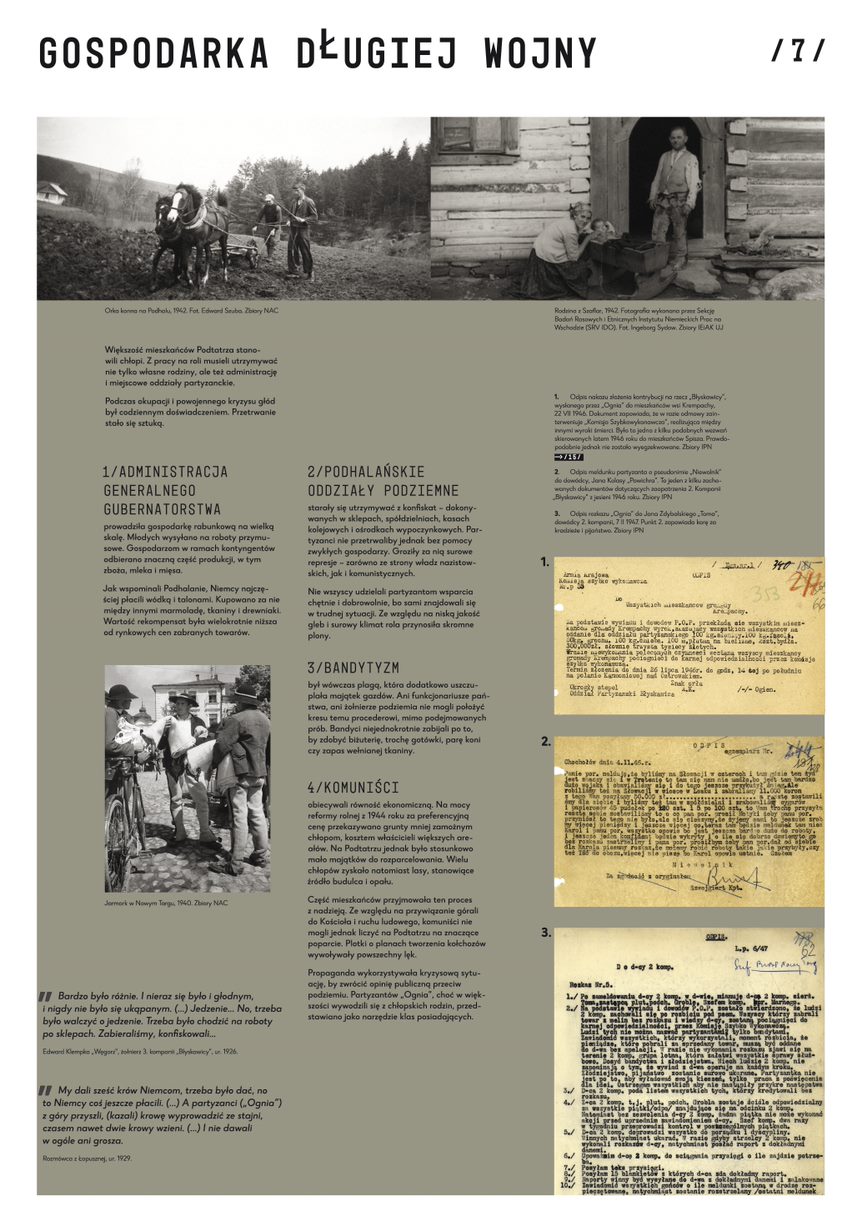
The majority of inhabitants of the Podtatrze region were peasants. Their fields had to provide not only for their families, but also for the local administration and partisan groups.
The administration of the General Governorate
Introduced large-scale exploitation economy. Young people were sent to forced labour. Contribution quotas deprived households of much of their produce, including grain, milk and meat.
As stated by local residents, Germans usually paid in vodka and vouchers. These were used to purchase e.g. marmalade, fabrics and wooden clogs. The value of the compensation was several times lower than the market price of the requisitioned goods.
The underground units of the Podhale region
Tried to survive through appropriation – in shops, cooperatives, railway ticket offices and leisure resorts. However, the partisans would never have made it without the help of ordinary farmers. Such assistance was punishable by severe repressions, both by Nazi and later by Communist authorities.
Not everyone supported the partisans gladly or of their own volition, as their own situation was dire. Due to the low quality of the soil and the harsh climate, the land yielded only a meagre crop.
Banditry
Was widespread at the time, and depleted the householders’ resources even further. Despite all efforts, neither the state officials nor the underground soldiers were able to put an end to this practice. Bandits frequently killed locals just to get their jewellery, a bit of cash, several horses or a batch of woollen cloth.
Communists
Promised economic equality. Under the agrarian reform of 1944, the less affluent peasants were offered land at preferential prices, at the expense of landowners with more acreage. However, in the Podtatrze region the number of larger estates that could be divided was relatively small. Many peasants were given the ownership of forests, a source of firewood and building materials.
Some of the locals welcomed this process with a hopeful heart. However, due to the highlanders’ attachment to the Church and the peasant movement, the communists could not count on much support in the Podtatrze region. Rumours about plans to establish kolkhozes caused widespread fear.
Propaganda used the state of crisis to turn the public opinion against the underground fighters. “Ogień’s” partisans were portrayed as an instrument of the moneyed classes, even though most of them came from peasant families.
The situation varied. You would often be hungry, and you would never be clean. (…) Food... Well, you had to fight for food. You had to go do your work at the shops. We would take, confiscate... – Edward Klempka “Węgorz”, soldier of the 3rd company of “Błyskawica”, b. 1926.
We gave six cows away to Germans, it was necessary to give them away, and the Germans paid something at least. (…) While the partisans [“Ogień’s” men] came down the mountain, [ordered] the cow to be brought from the stable, sometimes they would even take two cows. (…) And they didn’t pay a penny. – male interviewee from Łopuszna, b. 1929.
During the occupation and the post-war crisis, hunger was an everyday experience. Surviving became an art.
Visual materials:
Photograph of a fair. Nowy Targ 1940. National Digital Archives
Ploughing the fields. Podhale 1940. National Digital Archives, photo by Edward Szuba
Higlander family. Szaflary 1942. Sektion für Rasse-und Volkstumforschung, Institut für Deutsche Ostarbeit (SVR IDO), photo by Ingeborg Sydow
Copy of a report by “Niewolnik”, a soldier of the 2nd company in the “Błyskawica” group addressed to the commander, “Powicher”, 4 Nov. 1946. Collection of IPN
“Ogień’s” orders for the commander of the 2nd company, dated 7 Feb. 1947. Collection of IPN
A leaflet distributed by the Communist authorities in Podhale. Collection of the Institute of National Remembrance.
Propaganda poster from the pre-referendum period
The falisfied referendum of 30th June 1946 was meant to legitimise the Communist rule. The questions pertained to support for the dissolution of the Senate, changes to the economic system and the new shape of the northern and western borders. The propaganda campaign encouraged people to answer each of them with a “yes”. This poster, modified by unknown perpetrators, was included in the files on the “Błyskawica” group compiled by the Security Department. Archives of the Institute of National Remembrance.
